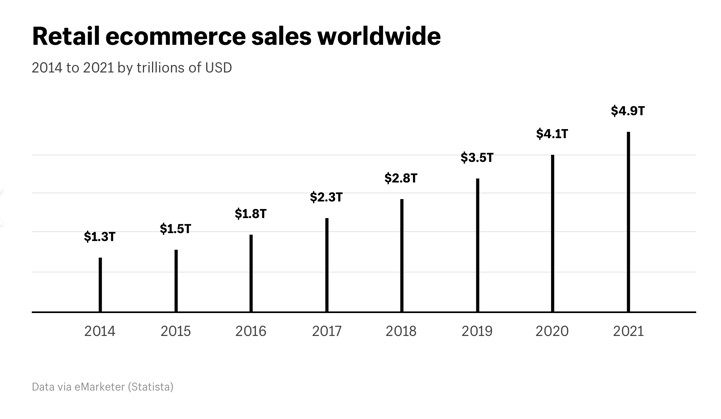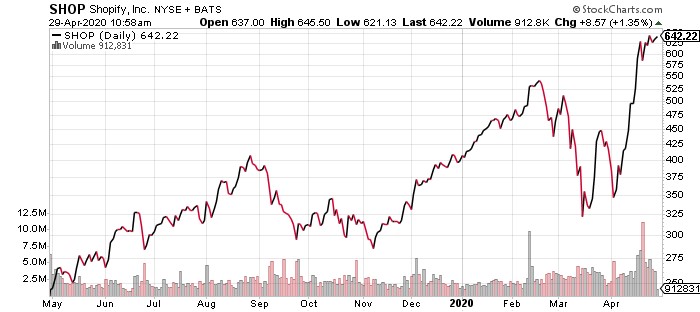This Ecommerce Company is Vital in the New Age of Retail
Thousands of small businesses all over the country are opening again for the first time in weeks.
Georgia Gov. Brian Kemp says business owners are thrilled to be open. Patrons, according to a CNBC report, appear to be more cautious. The COVID-19 pandemic might have changed retail for good.
When one door closes, another one opens. And this closing door is a big opportunity for digital retail.
With that said, the digital transformation in retail is not a new story. Amazon.com (AMZN) has been gobbling up unprecedented retail market share since 1994. The Seattle online store morphed from selling books and DVDs to almost every product under the sun. Sales zoomed from $610 million in 1998 to a staggering $232 billion two decades later.
The genius of the business model often goes underreported. In a letter to shareholders in 2019, company founder Jeff Bezos claimed that more than half of sales now come from mom and pop stores under the Amazon umbrella. These small businesses sell bicycles, baby strollers, sunglasses, summer jackets and everything in between.
For only $39.99 per month, plus 15% of gross sales, sellers can reach 300 million Amazon.com customers worldwide. Add Fulfilment by Amazon and vendors can even leave the shipping, returns and customer service to Amazon.com, too. It’s a turnkey business opportunity without the fixed costs of warehouse rent, bandwidth and ecommerce software.
In the era of pandemic lockdowns, the business model looks extremely prescient.
Main street American businesses are discovering this the hard way. The COVID-19 crisis means many fewer, if any customers, for brick and mortar stores. And like I said, even the prospect of reopening will not immediately ensure a return to happy days. The light foot traffic in Georgia this week is a testament to the reality that consumers are reluctant to go back to normal, regardless of what governors and a vocal minority of protestors say.
The new normal is nervousness and reduced sales.
Given what we now know about retail’s situation, there’s one company I particularly want to point out. It’s a Canadian software company called Shopify (SHOP) and most investors still don’t know about it.
Shopify makes software and services to help main street businesses move their storefronts online. Marketing gurus call this an omnichannel, the ability for customers to buy products both online and in physical stores. At Shopify, managers call it “the business model”, and now they’re making it even easier for mom and pop.
In the past, Shopify customers had to do their own fulfillment. That meant schlepping products down to the local FedEx (FDX) store or post office. However, last June, The Financial Post reported the company added a fulfillment network, better customer-facing software tools and developer kits to make it easier to embed its software applications on small business websites.
These additions make Shopify a full cloud-based e-commerce platform. Customers can easily monitor their web, mobile, social media and physical storefronts. They can manage inventory, process and ship orders and build customer relationships. There is even robust data analytics and financial reporting tools, as well as access to financing.
You might think these developments would put Shopify in Amazon’s crosshairs, but the relationship is more complex. While both companies compete for third-party retailers, the actual relationship is friendly.
Amazon Webstores began in 2010 as a way for sellers to access Amazon.com distribution. Sellers paid a monthly fee of $78 and about 3% of sales. But the online giant closed that business to new sellers in 2015. And that very decision led to the rise of Shopify.

Amazon Marketplace has since replaced Webstores. Most of the biggest sellers use both Webstores and Shopify, making the services weirdly codependent. Both need a healthy third-party seller ecosystem to source more products and grow the ecommerce pie.
The global ecommerce market was $2.8 trillion in 2018, according to a research report from Digital Commerce 360. It is expected to reach $4.9 trillion by 2021. And Statisa, another data analytics company, shows that online sales are projected to reach 17.5% of overall sales by 2021.
Shopify is integral to helping small businesses get their fair slice on that business. The global pandemic is hastening that process.
Jean-Michael Lemieux, the chief technology officer of Shopify, tweeted on April 20 that the company is handling as much traffic every day as it does on a typical Black Friday, which is typically the busiest ecommerce day of the year. For context, in 2019, Investor’s Business Daily reported the company had $2.9 billion in sales between Black Friday and Cyber Monday.
Currently, Shopify is tiny. The value of all goods sold on its platform in 2018 amounted to only $41 billion, or 1.5% of global online sales. The bet is Shopify can grab a bigger piece of that pie as it emerges as one of the platform winners. It’s a wise bet.
Commission revenue jumped to $1.6 billion in 2019, a 47% increase year-over-year. The company is also aggressively building out its portfolio with best-in-class value added products and services main street retailers will need to compete with Amazon.com.
Shopify shares are up 61% in 2020. As the market begins to wake to its inherent value as a platform in a rapidly growing market, valuation is certain to rise.
Longer-term investors can buy the stock into weakness.
Best wishes,
Jon D. Markman


